Performance Evaluation of Home Scale Wind Turbines – Kortright Centre, Vaughan
The use of home scale wind turbines to generate electricity is not new but with ever-increasing interest in renewable energy, it is becoming more commonplace. How much energy these “suburban” turbines will produce, for how long and with what degree of neighbour acceptance remains to be seen. Presently, the Small Wind Turbine industry does not have any set standards for approving or rating products. This lack of standards has led to inconsistent and inflated performance claims from some manufacturers, which in turn has created uncertainty in the marketplace.
This study helps address these uncertainties by providing independent verification of home scale turbines using a standardized wind test protocol and assess the viability of wind turbines when used in an urban setting to produce renewable energy and provide ‘real world’ data, useful to system designers and prospective users. The three turbines monitored have manufacturer’s rated output of 1 kW, 2.4 kW and 10 kW and installed on 55, 50 and 60 foot towers, respectively. Results show that the turbines were underperforming when compared to their manufacturer rated power output. The 2.4 kW turbine had the largest deviation from expected results as it underperformed by 34%. Parallel monitoring of photovoltaic panels as part of another ongoing STEP study allowed for the unit cost of wind turbines to be compared directly with the unit cost of photovoltaic panels. Results indicate that the inadequate wind regime at Kortright resulted in long payback periods for wind turbines, while solar panels generated enough power to result in reasonable payback of approximately 7 years.

